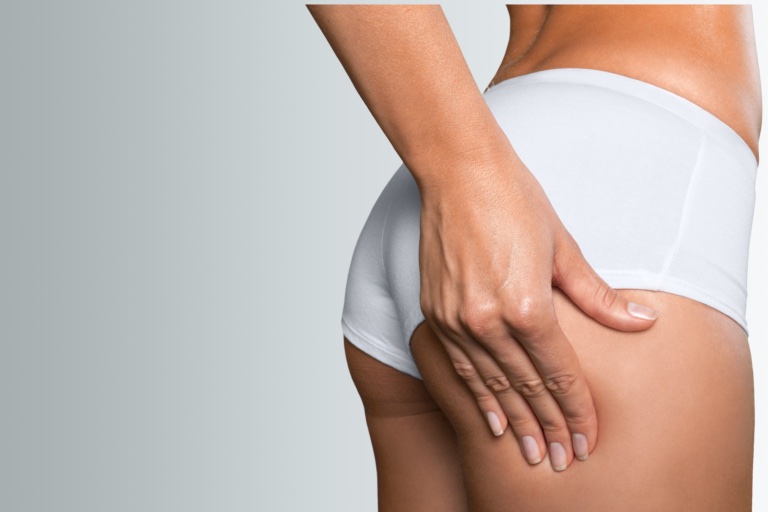 Are you noticing your buttocks looking flatter, looser, or less defined than before? Whether it’s from rapid weight loss with medications like Ozempic, years of running and endurance training, or the natural effects of aging, “Ozempic butt,” “runner’s butt,” and “accordion butt” are common concerns we’ve noticed at Chrysalis Cosmetics.
Are you noticing your buttocks looking flatter, looser, or less defined than before? Whether it’s from rapid weight loss with medications like Ozempic, years of running and endurance training, or the natural effects of aging, “Ozempic butt,” “runner’s butt,” and “accordion butt” are common concerns we’ve noticed at Chrysalis Cosmetics.
As a board-certified Sacramento plastic surgeon with over 20 years of experience, Dr. Charles Perry specializes in restoring volume, lift, and shape to the buttocks. From natural solutions like squats and lunges to CoolToning® and advanced procedures such as the Brazilian butt lift, gluteal implants, and buttock lifts, there are safe and effective options to help you achieve a fuller, more youthful silhouette.
Ozempic Butt
Dr. Perry has seen countless patients who are concerned about the appearance of their buttocks. Over time, certain trends and terms have emerged (e.g. “Ozempic butt,” “runner’s butt,” or even “accordion butt”). While these phrases may sound casual or humorous, they represent a very real concern for many patients: the flattening, deflation, or sagging of the buttocks.
The good news is that there are effective solutions. Whether caused by medication-induced weight loss, genetics, aging, or lifestyle, flat buttocks can often be reshaped and rejuvenated. Today, Dr. Perry will review the main causes and outline both non-surgical and surgical treatments available, ranging from exercise and nutrition to fat transfer, buttock lifts, implants, and cellulite treatments.
Why Do Buttocks Lose Volume or Shape?
1. Weight Loss and “Ozempic Butt”
Medications like Ozempic and other GLP-1 agonists have surged in popularity for weight management. However, rapid or significant weight loss often leads to volume depletion in the buttocks. This results in sagging skin, deflation, and loss of projection – or what patients call “Ozempic butt.”
2. Genetics and “Runner’s Butt”
Some individuals, particularly endurance athletes (such as runners), naturally burn more fat and carry less volume in the gluteal region. This can lead to what’s often called “runner’s butt” – a lean but flat appearance despite being in excellent physical shape.
3. Aging and Skin Elasticity
As we age, skin elasticity diminishes, collagen and elastin fibers weaken, and fat distribution changes. This can create a “pancake” or “accordion” look, where the buttocks appear flatter and more wrinkled.
4. Body Composition and Muscle Tone
The gluteal muscles (gluteus maximus, medius, and minimus) provide much of the natural lift and contour of the buttocks. If underdeveloped or weakened, the area can look flat even in the absence of weight loss or skin laxity.
Non-Surgical Treatments for Flat Buttocks
Not every patient needs surgery. Some cases can be improved significantly with lifestyle changes and minimally invasive treatments:
1. Targeted Weight Training
Exercises such as squats, lunges, and deadlifts are essential for developing gluteal muscle tone and projection. For patients not ready for surgery, a dedicated gluteal strengthening program can yield natural, gradual improvements.
2. Nutrition and Weight Gain (When Appropriate)
For patients who are underweight or who have lost excessive fat, a modest weight gain combined with strength training can restore some of the natural volume.
3. Injectable Fillers for Cellulite and Minor Volume Loss
Dermal fillers can be used to smooth superficial cellulite and provide subtle volume restoration. They are best for localized concerns rather than major reshaping.
4. Avéli™ for Cellulite
Avéli™ is a minimally invasive treatment designed to address cellulite dimpling by releasing fibrous septa beneath the skin. This can help create a smoother, more youthful buttock surface when combined with other contouring options.
Surgical Treatments for Buttock Rejuvenation
When lifestyle changes and non-surgical options aren’t enough, surgical procedures can dramatically reshape and restore buttock contour:
1. Brazilian Buttock Lift (BBL) / Fat Transfer
A Brazilian butt lift involves harvesting fat through liposuction (commonly from the abdomen, flanks, or thighs) and transferring it into the buttocks for volume and projection. This remains one of the most popular options for patients who have adequate donor fat. It creates a natural look and feel.
2. Gluteal Implants
For patients who are lean and do not have sufficient donor fat, gluteal implants can provide structure and projection. Modern implant techniques have improved significantly, offering safe and durable results.
3. Buttock Lift/Posterior Thigh Lift
For patients with significant skin laxity, a buttock lift or posterior thigh lift may be required. These procedures remove excess skin and elevate the tissues, creating a firmer, more youthful contour. Sometimes these are combined with fat transfer or implants for best results.
4. Combination Treatments
Often, the best results are achieved with a combination approach: for example, a posterior thigh lift with fat transfer, or implants combined with cellulite treatments. Each patient’s anatomy and goals are unique, so treatment plans must be personalized.
Our Plastic Surgeon’s Approach
When patients come to Dr. Perry with concerns about a flat backside, his first step is a thorough consultation. He evaluates:
- The underlying cause (weight loss, aging, genetics, muscle tone)
- The quality of skin and elasticity
- The availability of donor fat
- The patient’s lifestyle and goals
From there, Dr. Perry creates a customized plan. For some, this might be as simple as a workout regimen and nutrition counseling. For others, surgical intervention provides the best solution.
Encouragement for Patients
It’s important to remember that a flat buttocks is not a failure or flaw; it is a natural outcome of how your body stores fat, responds to weight changes, or ages over time. The most important step is deciding whether you’d like to improve it and then exploring the many safe, effective options available today.
With over two decades of surgical experience, Dr. Perry can confidently say that we now have more tools than ever to restore shape, volume, and confidence. Whether through exercise, fat transfer, implants, skin tightening, or cellulite treatments, you don’t have to settle for a silhouette you’re unhappy with.
Final Thoughts
The terms “Ozempic butt” and “runner’s butt” may sound unflattering, but they all describe a very common and very treatable condition: a loss of buttock volume and contour. If this is something you’re experiencing, know that you have options ranging from natural strengthening to advanced surgical techniques.
The journey to a more lifted, fuller, and youthful backside begins with a conversation. If you’re ready to explore treatment, we encourage you to schedule a consultation with a board-certified plastic surgeon who specializes in body contouring.
Because the truth is simple: you don’t have to live with a flat butt if it bothers you. There are safe and proven ways to restore curves, projection, and confidence.



